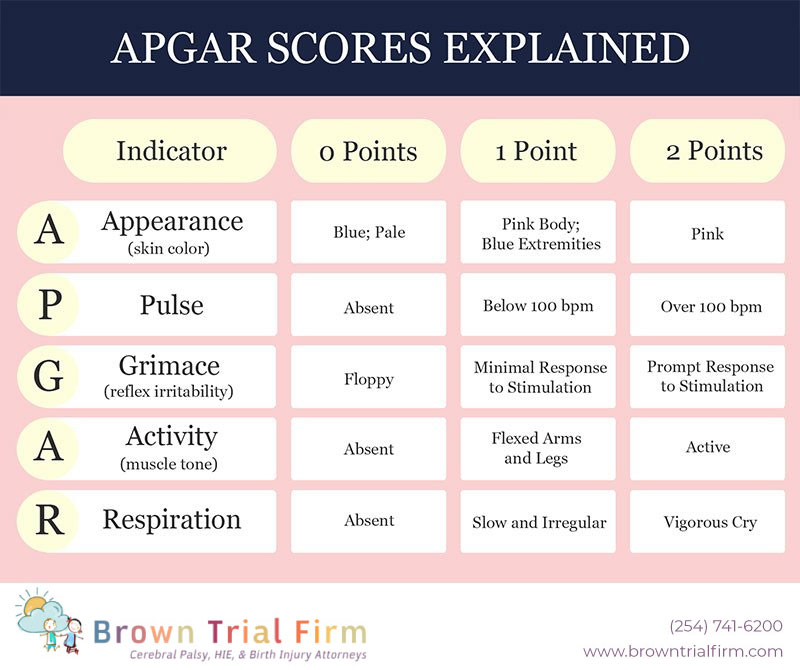Understand when a low Apgar score could be a sign of medical negligence
New parents are often surprised to discover that their newborn receives their very first test in life within moments of entering the world. While you might be busy gazing in wonder at your little one’s beautiful features, the doctors and nurses are actively gauging several important characteristics that give a glimpse into their overall well-being.
Knowing what an Apgar score means helps you to understand what your care team is talking about when they give you an update on your newborn’s health status, and you’ll be better prepared to address the potential reasons why your baby might receive a low score.
Who created the Apgar score?
The Apgar scoring system was first developed and used in 1953 by Dr. Virginia Apgar. At the time, she was serving as the director of obstetric anesthesia at Presbyterian Hospital, and there weren’t any formal protocols regarding when or how to provide medical intervention to infants who experienced respiratory distress and other concerning issues shortly after birth.
As a leader in her field, Dr. Apgar created the scoring system as a response to a student’s question regarding what they should be looking for when they provide a newborn with a visual exam.
After presenting the scoring system to her colleagues in a national anesthesiology meeting, it was published in a complete manuscript in 1953. Shortly after its publication, the score became used throughout the healthcare profession to identify newborns who were in need of intensive medical assistance.
How is the Apgar score performed, and what does it measure?
A baby’s Apgar score is a simple test given to a baby after birth. This scoring system is a method of measuring a baby’s vitals and overall health shortly after they’re born.
Your baby’s Apgar score is what doctors will use to check their heart rate and muscle tone, as well as other signs that may indicate that your baby requires additional medical care or emergency care.
The Apgar test is a standard procedure, and it’s administered for every infant; however, your baby’s score will determine how medical staff care for them during their first few days at the hospital.
Generally speaking, a low Apgar score is an indicator that something may be wrong with the baby. Resuscitation and or treatment may be necessary for a baby with a low score.
At the one-minute mark, notes are taken regarding the following characteristics that form the acronym APGAR.
- A = Appearance, which involves the skin color
- P = Pulse or heart rate
- G = Grimace response, which is their natural reflex
- A = Activity or muscle tone
- R = Respiration rate and breathing effort
Apgar scores are only part of the information that should be evaluated immediately after birth.
What does my baby’s Apgar score mean?
Each of these characteristics is given a score from 0 to 2. Then, each element is added up to determine the final Apgar score. The maximum possible score is a 10, while the lowest possible score is a 0.
<a href="https://browntrialfirm.com/" target="blank"><img src="https://browntrialfirm.com/infographics/apgar-scores-explained.jpg" alt="APGAR scores explained" title="APGAR scores" style="width: 100%; max-width: 800px; display: block; margin: 15px auto;" /></a>
0 Points = Bluish-gray or pale all over
1 Point = Normal color (but hands and feet are bluish)
2 Points = Normal color all over (hands and feet are pink)
0 Points = Absent (no pulse)
1 Point = Pulse below 100 beats per minute (bpm)
2 Points = Pulse over 100 beats per minute (bpm)
0 Points = Absent, no response to stimulation
1 Point = Facial movement only, grimacing with stimulation
2 Points = Pulls away, sneezes, coughs, or cries with stimulation
0 Points = No movement, or “floppy” tone
1 Point = Flexed arms and legs with little movement
2 Points = Active, spontaneous movement
0 Points = Absent, no breathing
1 Point = Slow or irregular breathing, weak crying
2 Points = Normal rate of breathing and effort, good crying
Most babies won’t receive a perfect 10 because, frequently, a newborn’s hands and feet stay slightly bluish until they get warm, and there are still some inconsistencies regarding the scoring system on the higher level. For instance, the frequency of perfect 10 scores can range from 8.8% to 92.7% in different countries.
If the baby’s score does not improve between the first test at 1 minute after birth and the second test 5 minutes after birth, the doctors and nurses should continue to monitor the baby and give the baby any necessary medical care.
If you aren’t sure if your baby has suffered a birth injury, contact us. We will do a free case review to help you determine whether your child was injured by negligence.
What is the biggest impact of using the Apgar score test?
While the difference between a score of 9 and 10 might seem minimal, the real impact of the Apgar test is noticeable when one takes a look at how the lower-scoring infants face a higher risk of mortality.
During her studies, Dr. Apgar found that infants who had scores in the 0 to 2 point range had a neonatal mortality rate of 14%. Compared to a mortality rate of only 0.13% for those who had scores within the range of 8 to 10, it became clear that focusing on providing the low-scoring infants with prompt and intensive medical care could improve their chances of surviving beyond the first month of life.
Today, these findings still hold true, and using the scoring system has helped to save countless newborns’ lives over the years.
What causes a low Apgar score?
If your baby has a low Apgar score, which is defined as 6 or below, they may have signs such as a slow heart rate or no heart rate, weak breathing or no breathing, little flexion or no muscle tone, little to no response to stimulation, and little to no color, which means poor blood flow or circulation.
These signs are obviously cause for concern, and medical staff will respond accordingly. The causes of these signs can vary, but the most common causes of these signs include:
- Oxygen deprivation. This means that your baby’s brain is not getting enough oxygen or, in some cases, may be completely deprived of it. Brain damage can result depending on the extent and length of deprivation your baby has experienced.
- HIE. When a baby’s brain is deprived of oxygen, their brain cells can become injured. If your baby is suffering from HIE, medical staff may proceed with infant cooling, which is a multiple-day process that will slow down and prevent damage to their brain cells.
- Cerebral palsy. Treatment is out there for cerebral palsy, which is a condition affecting your baby’s physical abilities. This congenital condition can last anywhere from a few years to a lifetime. It can be inherited through genes.
These causes have different treatment options, responses, and effects on your baby’s long-term well-being.
A low Apgar score is often associated with difficult birthing experiences. Babies who are from a high-risk pregnancy or a premature birth tend to have lower Apgar scores. Prolonged deliveries and delayed cesarean sections (C-sections) can lead to fetal distress, which is noticeable in the characteristics that the Apgar score measures in the first few minutes after birth.
Although issues such as poor respiration might resolve later on, there is a chance that they could have long-term implications for the baby’s future development.
Getting help for a child with HIE or Cerebral Palsy
can make a big difference
Because early intervention is often key to helping improve a child’s wellbeing, it’s important to act swiftly. At the Brown Trial Firm, our Houston birth injury attorneys can help you investigate your case, find answers to your questions, and determine whether you are entitled to compensation. We offer case reviews at no cost or obligation. Many birth injuries that cause cerebral palsy could have been prevented.
Up to 10% of newborns who are delivered in a hospital require assistance with their breathing for a brief period of time after they are delivered. While this can certainly be concerning to see as a parent, it is not necessarily an indication of your baby’s overall condition or future health. Medical staff will offer assistance to your baby as needed based on the results of their Apgar tests. If they have reason to believe that there are further complications or an underlying condition, they will treat your baby appropriately and inform you of that notion.
A low Apgar score doesn’t always mean that medical malpractice occurred, but it could indicate that physicians made poor decisions at some point during the pregnancy or child birthing process. In situations where a birth injury occurred and the baby had a low Apgar score, there is a higher chance that the decisions made by the medical team impacted the newborn’s health and safety. In some population studies, an Apgar score of less than 5 at the 5- and 10-minute marks has been shown to increase the risk of a baby having cerebral palsy, which could be related to a birth injury.
To find out whether a baby suffered a birth injury, there must be an evaluation of the medical records and information about the events that happened. The condition of the mom and the baby are important details. However, we frequently get questions from parents about the Apgar scoring system and how an Apgar score relates to a birth injury. Learn about 2 types of birth complications and why the distinctions are important to understand when it comes to filing a birth injury medical malpractice lawsuit. An Apgar score is one of the pieces of information to evaluate. If you aren’t sure if your child has suffered a preventable birth injury, the best thing to do is to contact a birth injury attorney for a consultation. An attorney can help investigate your case to find out what happened and whether the injury was preventable. Apgar scores are an effective tool for assessing a newborn’s general health within minutes after birth. However, they don’t tell the whole story. Doctors have a standard of care they owe to their patients, and all medical professionals are expected to watch for symptoms of developing medical conditions in mothers and babies to protect them when they’re most vulnerable. If you believe your doctor or other medical professional’s actions or inactions resulted in an injury to your baby, you may have cause to file a medical malpractice claim. Laura Brown at Brown Trial Firm has dedicated her practice to advocating for families who have experienced the loss of a child due to someone else’s negligence. She serves families nationwide, so contact her today for a free consultation.What is an assisted Apgar score?
Could a low Apgar score be an indicator of medical malpractice?
How do I know if my baby suffered a birth injury?
Contact a birth injury attorney




